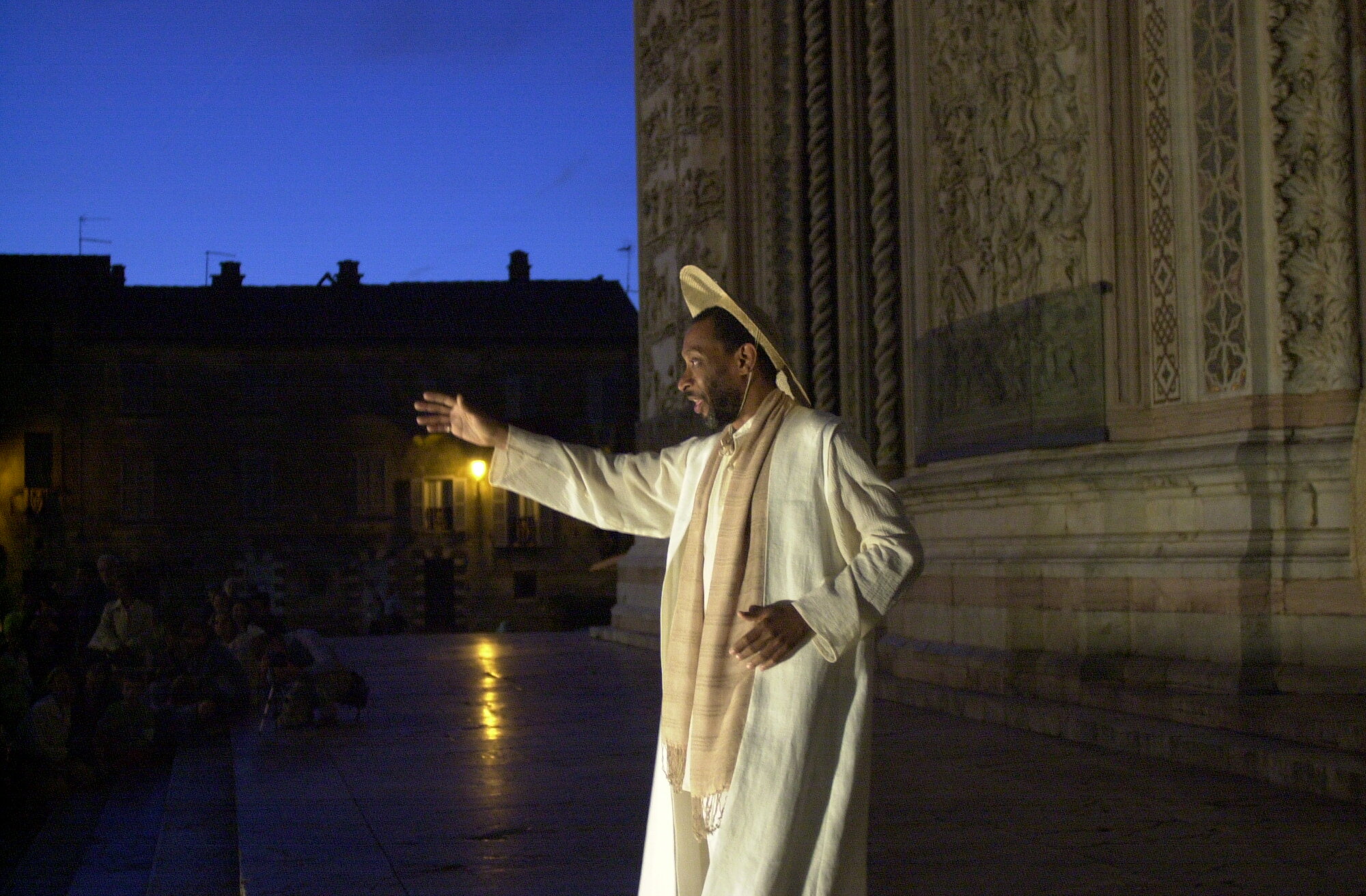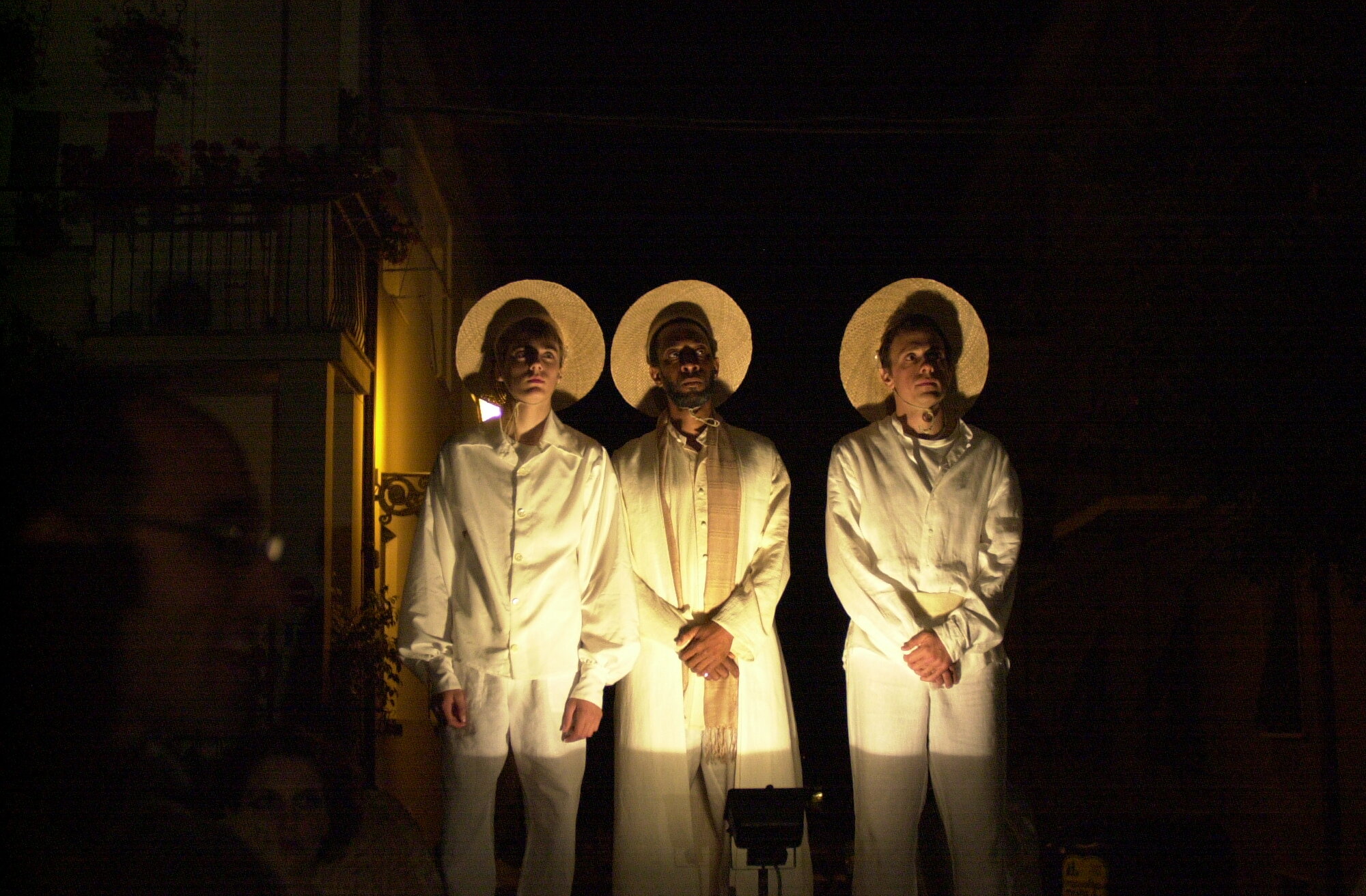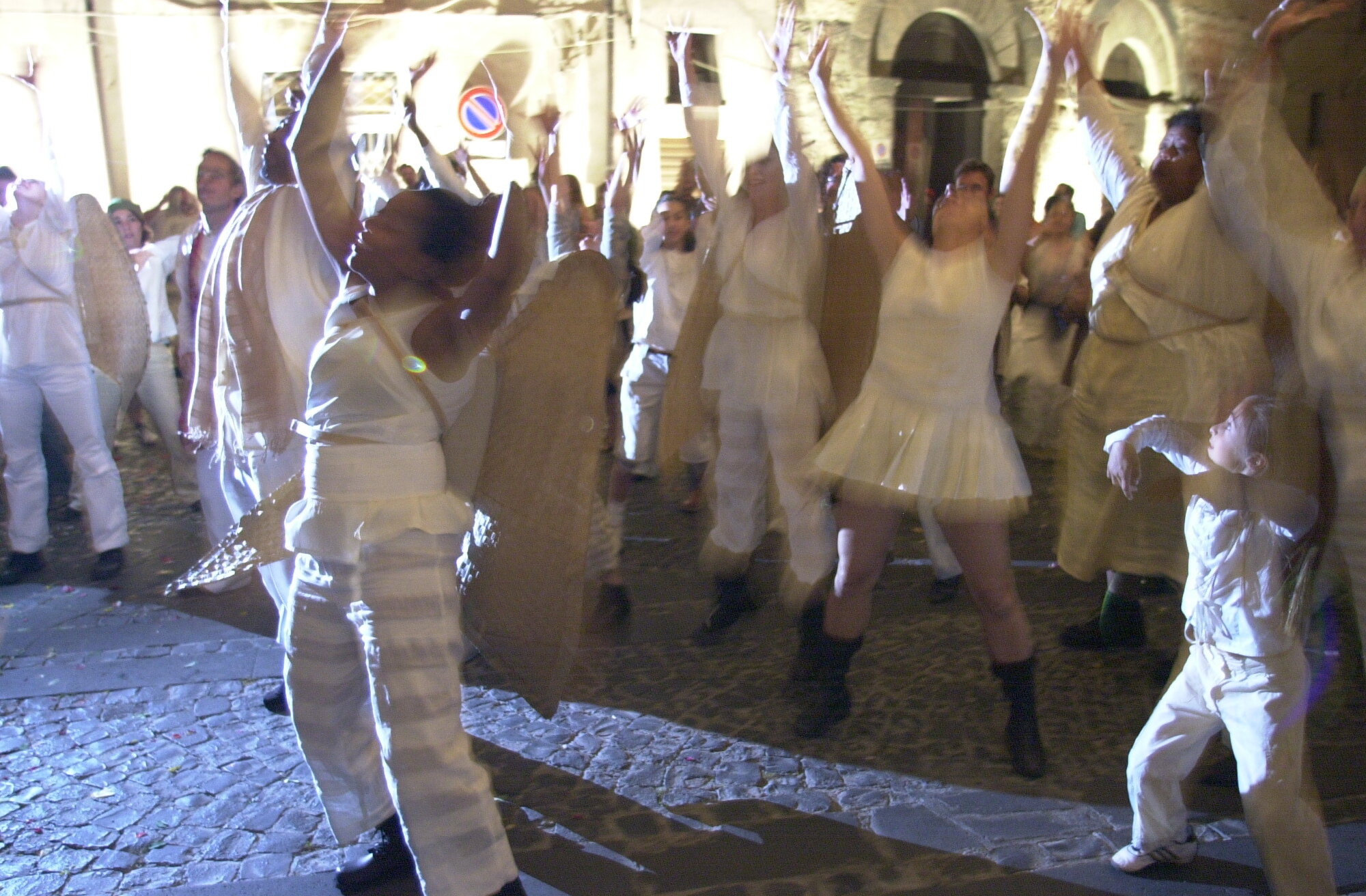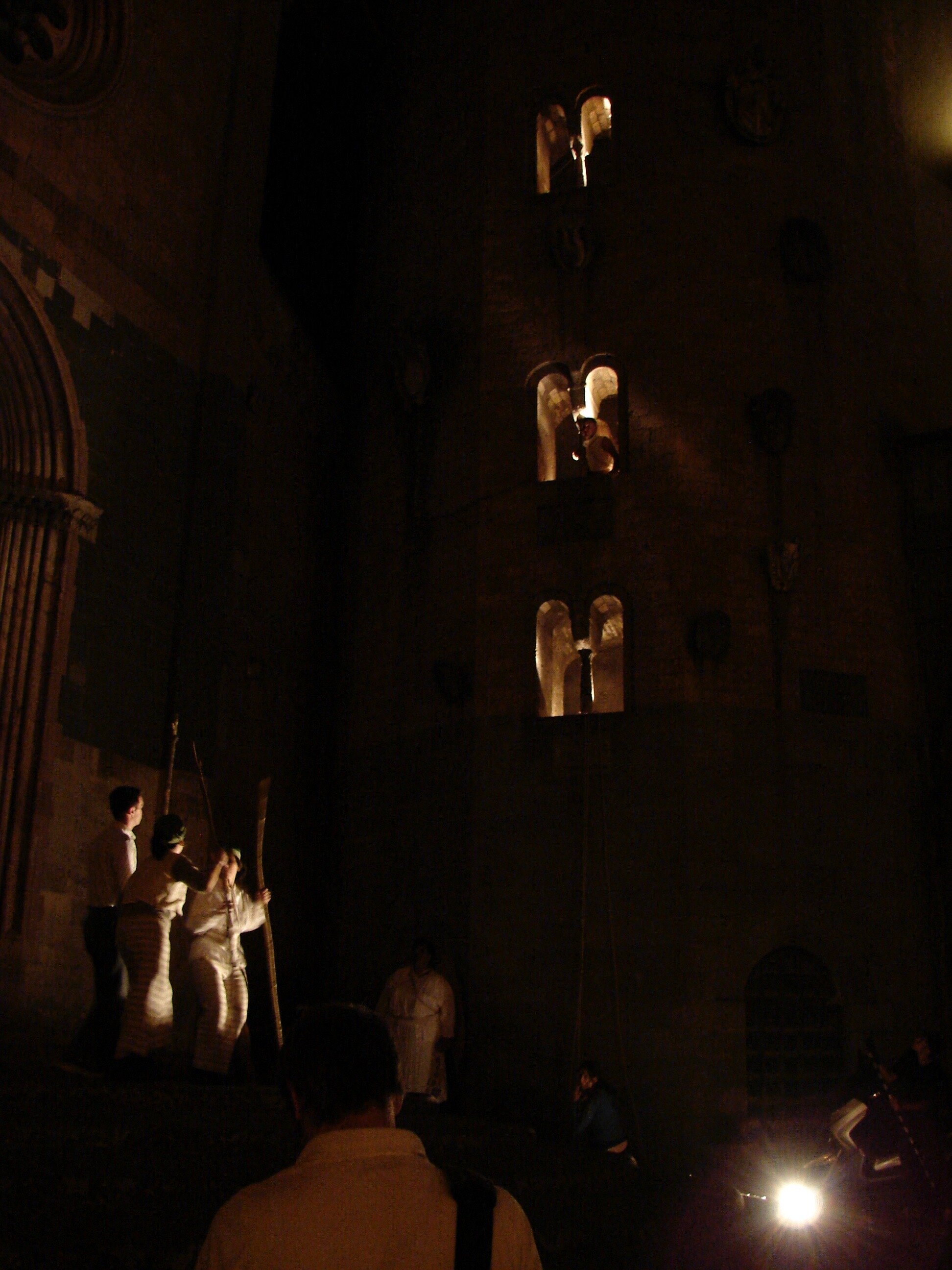Theater
The Studio’s vision for putting art back in its place applies not only to the visual arts but to
the theatrical and performance arts as well.
Since 2005, the Studio for Art, Faith & History has been partner to a substantial program of theater productions. These projects have woven together variously the three elements of the Studio’s name.
This on-going project was inaugurated in 2004 with the first of three versions of a set of plays directed by New York City theater artist Karin Coonrod, performed through the streets of Orvieto. The plays were chosen by John Skillen from the body of popular sacred drama in medieval England. Manuscripts exist from four towns of day-long series of plays performed as a parade of stage-wagons, dramatizing the entirety of Salvation History from Creation to Last Judgment. Skillen selected the play about the Resurrected Jesus meeting the two disciples on the Road to Emmaus as the frame, imagining the plays as what Jesus might have “said in all the Scriptures concerning himself.” Coonrod’s remarkable essay about the entire project is found HERE on the Studio website.
In the years since, Skillen and Orvietano theater artist Andrea Brugnera have created and produced eight plays, some based on medieval sources, others adapting the tradition of sacre rappresentazioni to contemporary subjects.
For illustrated accounts of each of these plays, click on the boxes below.
Scroll down for a brief essay explaining why the Studio has invested in theater performed in non-theater places.
Why perform plays in the public, civic, and sacred places of communities?
For most of us, the typical experience of going to the theater goes something like this: buying our tickets, making a date of it, sitting quietly in the darkness as the lights dim and the curtain opens on the proscenium stage, clapping, returning to the parking lot. We may be moved emotionally and aesthetically by a good play well acted and beautifully staged, but often we are not clear about how the experience could or should provoke longer-term adjustment to how we live, personally and in the communities where our regular lives unfold.
Such experience is a distinctly modern phenomenon. During two millenia of pre-modern Western cultural history, drama was mainly performed in public spaces, available at no or low cost to a wide swathe of the citizenry, performed by a mix of local amateurs and professional actors, and always in some fashion incorporated purposefully into the collective religious life of the community.
The great masterworks of ancient Greek theater that have come down to us were staged as part of the annual religious festival in honor of the god Dionysius. A competitive selection process determined which plays would be staged, and their production was funded largely by wealthy patrons as part of their own civic and religious obligation to contribute to the welfare of the polis.
Such religiously-freighted theater was re-fashioned in Christianized Europe. Plays were endorsed by the local Catholic church, but were mounted by local guilds and confraternities (as parachurch activities, we might say). The plays were typically coordinated with the liturgical calendar of the Church year. They brought Bible stories—as well as a number of well-beloved stories from the non-canonical scriptures—out of the Mass (where the lectionary readings were presented in Latin) and into the daily contemporary lives and settings of the citizens, presented in the local vernacular, full of local references.
In England, lengthy cycles of plays were performed over an entire day or more. In several towns these cycles became associated with the celebration of the late-spring holy-day of Corpus Christi—the Body of Christ in the sacrament and in salvation history. (The Orvieto connection: this Feastday of the Church was established by Pope Urban IV from his seat in Orvieto in 1264.) Manuscript versions of the scripts produced in four towns in England have come down to us.
The hunch of the Studio is that these pre-modern forms of theater have new timeliness, and are worth revitalizing … but not as medievalized costume plays. Rather, in manners that give local immediacy to the themes and narratives and scriptural sources of these plays for our own day.
From this hunch has come the series of plays produced by the Studio in collaboration with two gifted theater artists: New York City director Karin Coonrod, director of the Compagnia de’ Colombari, and Orvietano actor and script-writer Andrea Brugnera and his Kamina Teatro.
In Orvieto, the Studio benefitted from the early interest of Coonrod, acclaimed for her productions of Shakespeare and of stories by Flannery O’Connor, and of exuberant staged recitations of the poetry of Walt Whitman performed in public spaces. (A recent essay in IMAGE journal profiles the work and career of Coonrod, written by John Skillen.)
Visiting Orvieto and the Skillens back in 1998, Coonrod immediately recognized Orvieto as a place ripe for re-envisioning the medieval cycles for community-wide performance in the streets and piazzas and churches. Coonrod took up Skillen’s idea of using the play of the resurrected Jesus’s Supper at Emmaus as a frame for six plays from the cycles. Coonrod fashioned Laude in Urbis (later with the title of Stranieri ed altri Angeli [Strangers and other Angels] performed during the holiday season of Corpus Christi in 2004, ‘06 and ‘07. Coonrod’s captivating essay on the project of Laude in Urbis can be found here in the Studio website, as well as her essay about her production of Shakespeare’s Merchant of Venice in Venice.








I remember being drawn aside by the distinguished elderly priest of the church of Sant’Andrea, Monsignor Marcello Pettinelli, who said, with deep appreciation, “you [strangers] have given us back our own tradition.”
One of Coonrod’s local professional actors—theater artist Andrea Brugnera, director of KaminaTeatro—has partnered with the Studio for Art, Faith & History to create and perform a sequence of eight plays that, taken together, represent a revitalization of Orvieto’s own tradition of sacre rappresentazioni (theater of the sacred).
Several are new adaptations of medieval plays, including The Tree of Life, Balaam and His Ass, San Giovenale (the bishop from North Africa who evangelized Umbria), The Harrowing of Hell, the penitent Julian the Hospitaller. But several other plays apply the tradition of medieval sacred drama to modern subjects and contemporary texts: a retelling of Job by the French theologian and novelist Fabrice Hadjadj, an original play about the 20th-century polymath-priest-martyr Pavel Florensky, and (to be performed in February 2020) a play about the Carmelite nuns martyred during the French Revolution, adapted from a novel and an opera and a film script about these courageous nuns.










